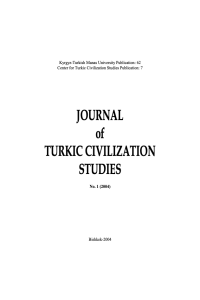DIWANU LUGATI’T-TURK AND CONTEMPORARY LINGUISTICS
Öz
The branches of linguistics such as Sociolinguistics and Applied Linguistics are relatively young disciplines compared to the much older fields of linguistics such as General Linguistics, Historical Linguistics, and Theoretical Linguistics.1 These new disciplines have not only brought new dimensions to linguistics, but have also expanded our general understanding of the world languages. In this article, I will attempt to evaluate both the approaches and techniques that had been employed in the composition of the eleventh century Turkic dictionary Diwanu Lugati’t-Turk (DLT) by Mahmud Kashghari (1072-1077).2 To undertake this task, I will examine this work consistent with the most recent approaches in Applied Linguistics and Sociolinguistics.
Anahtar Kelimeler
Kaynakça
- Ahmet Caferoğlu, Türk Dili Tarihi, Cilt II. Istanbul, 1972, p. 21. (its new edition with both volumes together: Ahmet Caferoğlu, Türk Dili Tarihi. Istanbul: Enderun Kitabevi, 1984).
- Dankoff-Kelly, ibid., Part I, p. 71.
- Dankoff-Kelly, ibid., Part I, p. 24; the words in brackets are mine.
DIWANU LUGATI’T-TURK AND CONTEMPORARY LINGUISTICS
Öz
The branches of linguistics such as Sociolinguistics and Applied Linguistics are relatively young disciplines compared to the much older fields of linguistics such as General Linguistics, Historical Linguistics, and Theoretical Linguistics.1 These new disciplines have not only brought new dimensions to linguistics, but have also expanded our general understanding of the world languages. In this article, I will attempt to evaluate both the approaches and techniques that had been employed in the composition of the eleventh century Turkic dictionary Diwanu Lugati’t-Turk (DLT) by Mahmud Kashghari (1072-1077).2 To undertake this task, I will examine this work consistent with the most recent approaches in Applied Linguistics and Sociolinguistics.
Anahtar Kelimeler
Kaynakça
- Ahmet Caferoğlu, Türk Dili Tarihi, Cilt II. Istanbul, 1972, p. 21. (its new edition with both volumes together: Ahmet Caferoğlu, Türk Dili Tarihi. Istanbul: Enderun Kitabevi, 1984).
- Dankoff-Kelly, ibid., Part I, p. 71.
- Dankoff-Kelly, ibid., Part I, p. 24; the words in brackets are mine.
Ayrıntılar
| Birincil Dil | İngilizce |
|---|---|
| Konular | Dilbilim (Diğer) |
| Bölüm | Araştırma Makalesi |
| Yazarlar | |
| Yayımlanma Tarihi | 30 Haziran 2004 |
| Yayımlandığı Sayı | Yıl 2004 Cilt: 1 Sayı: 1 |
Journal of Turkic Civilization Studies © 2022 by TUAUM is licensed under Attribution-NonCommercial 4.0 International
Journal of Turkic Civilization Studies by TUAUM is licensed under Attribution-NonCommercial 4.0 International

